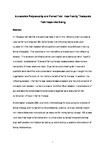Accessible polyvocality and paired talk: how family therapists talk positive connotation into being
| dc.contributor.author | Williams, L | |
| dc.contributor.author | Auburn, Timothy | |
| dc.date.accessioned | 2016-01-04T15:45:12Z | |
| dc.date.available | 2016-01-04T15:45:12Z | |
| dc.date.issued | 2016-11 | |
| dc.identifier.issn | 0163-4445 | |
| dc.identifier.issn | 1467-6427 | |
| dc.identifier.uri | http://hdl.handle.net/10026.1/4158 | |
| dc.description.abstract |
<jats:sec><jats:label /><jats:p>In this article we identify one particular way in which the reflecting team process is used by family therapists. We show that reflecting teams draw upon occasions in the main session to intensify and extend positivity in the reflecting session. This analysis identified positive connotation as a device by which a hopeful orientation is established. Videos of family therapy sessions were obtained and transcripts of these sessions made. Excerpts with hope and positivity were identified and conversation analysis was used to gain insight into the organization and function of this talk. In addition, therapist interventions occurring during the main therapy session and which were reworked in the reflecting session were identified and analyzed. Sixteen examples of this paired talk are presented, and two exemplars are analyzed in full. Main session interpretations of talk and the reflecting team second versions (a device identified as paired talk) were found to work together as a resource for the construction and reinforcement of positive connotation in family therapy.</jats:p></jats:sec><jats:sec><jats:title>Practitioner points</jats:title><jats:p> <jats:list list-type="bullet"> <jats:list-item><jats:p>Positive connotation is constructed through therapists’ talk; this study shows in close detail how positive connotation is ‘talked into being’.</jats:p></jats:list-item> <jats:list-item><jats:p>There is little opportunity for family members themselves to ratify or challenge these constructions.</jats:p></jats:list-item> <jats:list-item><jats:p>Practitioners could engage family members by gaining feedback on the constructions of positive connotation.</jats:p></jats:list-item> </jats:list></jats:p></jats:sec> | |
| dc.format.extent | 535-554 | |
| dc.language | en | |
| dc.language.iso | en | |
| dc.publisher | Wiley | |
| dc.subject | positive connotation | |
| dc.subject | reflecting team | |
| dc.subject | conversation analysis | |
| dc.title | Accessible polyvocality and paired talk: how family therapists talk positive connotation into being | |
| dc.type | journal-article | |
| dc.type | Journal Article | |
| plymouth.author-url | https://www.webofscience.com/api/gateway?GWVersion=2&SrcApp=PARTNER_APP&SrcAuth=LinksAMR&KeyUT=WOS:000388310200005&DestLinkType=FullRecord&DestApp=ALL_WOS&UsrCustomerID=11bb513d99f797142bcfeffcc58ea008 | |
| plymouth.issue | 4 | |
| plymouth.volume | 38 | |
| plymouth.publication-status | Published | |
| plymouth.journal | Journal of Family Therapy | |
| dc.identifier.doi | 10.1111/1467-6427.12096 | |
| plymouth.organisational-group | /Plymouth | |
| plymouth.organisational-group | /Plymouth/Faculty of Health | |
| plymouth.organisational-group | /Plymouth/REF 2021 Researchers by UoA | |
| plymouth.organisational-group | /Plymouth/REF 2021 Researchers by UoA/UoA04 Psychology, Psychiatry and Neuroscience | |
| plymouth.organisational-group | /Plymouth/REF 2021 Researchers by UoA/UoA04 Psychology, Psychiatry and Neuroscience/UoA04 Psychology, Psychiatry and Neuroscience MANUAL | |
| plymouth.organisational-group | /Plymouth/Research Groups | |
| plymouth.organisational-group | /Plymouth/Research Groups/Centre for Brain, Cognition and Behaviour (CBCB) | |
| plymouth.organisational-group | /Plymouth/Research Groups/Centre for Brain, Cognition and Behaviour (CBCB)/Behaviour | |
| plymouth.organisational-group | /Plymouth/Research Groups/Institute of Health and Community | |
| plymouth.organisational-group | /Plymouth/Users by role | |
| dc.identifier.eissn | 1467-6427 | |
| dc.rights.embargoperiod | Not known | |
| rioxxterms.versionofrecord | 10.1111/1467-6427.12096 | |
| rioxxterms.licenseref.uri | http://www.rioxx.net/licenses/all-rights-reserved | |
| rioxxterms.type | Journal Article/Review |


